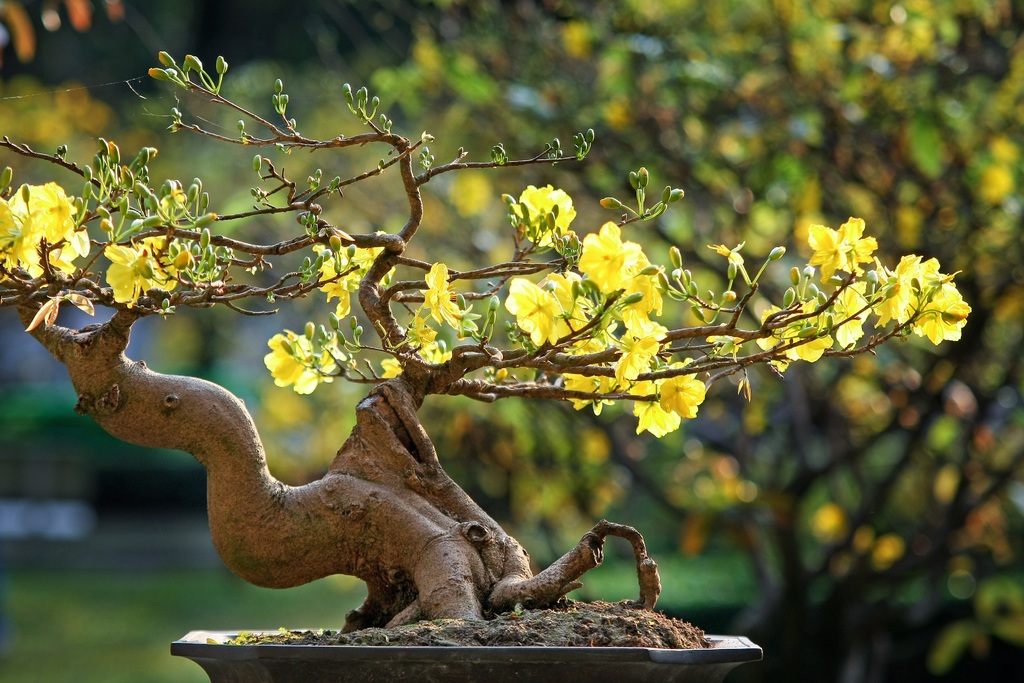Chapter 100 Jasminum sp.
100.1 Jasmines
There are two main species in bonsai: winter-flowering jasmine, Jasminum nudiflorum; and common jasmine, J. officinale.

A winter flowering jasmine bonsai. Link to image source.
100.2 Soil: General Deciduous / Rich Conifer Mix
Ratio: 3 parts bark, 1 part grit
Add-ins: dolomitic limestone (~5 lbs/yd), Tree-Tone (15 lbs/yd)
pH: ~6.5 (slightly below neutral)
Moisture: needs ample water and high humidity to flower.
100.3 Light
Routine: full sun.
Summer: may need some mid-day shade.
100.4 Cultivation Notes
100.4.1 Potting & Root Pruning
Schedule: repot every one or two years in spring. Repot winter jasmine after flowering, common jasmine as new spring growth extends. Both jasmines adapt well to life in a container.
100.4.1.1 Top & Branch Management

Flowers of winter jasmine. Link to original image.

Flowers and leaves of common jasmine. Link to original image.
Heavy pruning: for winter jasmine, prune the first flush of shoots hard in late spring. For common jasmine, prune back hard after the flowers fade. Let the hard-pruned branches sprout back and grow freely for the season, then shape the sprouted shoots in fall or the next spring.
Fine pruning: older shoots can be clipped to shape from late spring to fall.
Leaf pruning: unknown.
100.4.2 Feeding

Cascading growth of common jasmine in full bloom. Link to original image.
Winter jasmine can be fed every two weeks from the end of flowering until early fall. Common jasmine blooms later, so will need to be fertilized starting with leaf-out in spring.
Fertilizer with more nitrogen can stimulate rapid foliage growth, but will not promote flowering. A 7-9-5 fertilizer works well as a maintenance feed for jasmines.
100.4.3 Pests & Problems
No serious insect or disease problems.
100.4.4 Winter Storage
Both species are officially temperate, not tropical, so need a rest period. They will not thrive if kept indoors continuously. Common jasmine blooms from spring to fall and rests from October to March. Winter jasmine begins the resting and blooming stages earlier in the season.
Officially winter jasmine can tolerate light frost, but needs protection when temperatures drop below 28°F. Common jasmine is not frost-hardy, but also is supposedly hardy in Zones 7-10 (if planted in the ground). For convenience and safety, it is easier to treat them both the same, and bring pots into a protected garage or basement for the winter.
100.5 Propagation Notes
Both species are available in garden centers, but do not expect to find large trunks. Plan to spend several years developing the nebari.
100.6 Artistic & Styling Notes
100.7 Additional Information
100.7.1 Natural History
Jasminium is a genus of >200 species of deciduous and evergreen shrubs and climbers. Winter jasmine is a deciduous shrub native to China. Yellow flowers emerge in spring, followed by the leaves.
Common jasmine is a woody deciduous climbing vine. It is native to the Caucasus, northern Iran, Afghanistan, Pakistan, the Himalayas, Tajikistan, India, Nepal and western China. Fragrant, white flowers are produced from summer to early fall.